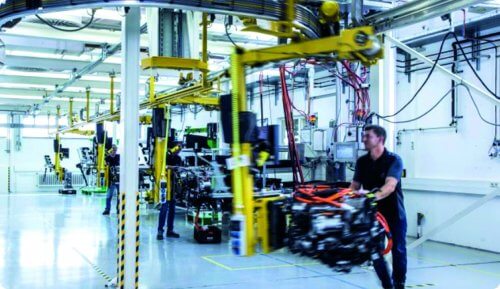
On 30 April Daimler Truck AG and Volvo Group officially outlined their roadmap for the new fuel-cell joint venture cellcentric, as part of an industry-first commitment to accelerate the use of hydrogen-based fuel cells for long-haul trucks and beyond. With the ambition of becoming a leading global manufacturer of fuel-cell systems, cellcentric intends to build one of Europe’s largest planned series production of fuel-cell systems, with operation planned to commence in 2025. To accelerate the rollout of hydrogen-based fuel-cells, the two cellcentric shareholders are calling for a harmonised EU hydrogen policy framework to support the technology in becoming a viable commercial solution.
These ambitions were revealed as part of an exclusive digital launch, led by Martin Daum, CEO of Daimler Truck AG, and Martin Lundstedt, CEO of Volvo Group. Designed to help meet the 2050 targets of sustainable transport and a carbon-neutral Europe as part of the European Green Deal, cellcentric will develop, produce and commercialise fuel-cell systems for both long-haul trucking and other applications.
According to Daimler Truck AG and Volvo Group, purely battery-electric and hydrogen-based fuel-cell trucks will complement each other depending on the individual customer use case. Battery power will be rather used for lower cargo weights and for shorter distances, while fuel-cell power will tend to be the preferred option for heavier loads and longer journeys.
Martin Daum, Chairman of the Board of Management of Daimler Truck AG and Member of the Board of Management of Daimler AG, said: “Hydrogen-powered fuel-cell electric trucks will be key for enabling CO2-neutral transportation in the future. In combination with pure battery-electric drives, it enables us to offer our customers the best genuinely locally CO2-neutral vehicle options, depending on the application. Battery-electric trucks alone will not make this possible. Together with our partner Volvo Group, we are therefore fully committed to our fuel-cell joint venture cellcentric and we are both pushing forward the development of the technology as well as the series production preparations. Regarding the necessary hydrogen infrastructure, it is clear that green hydrogen is the only sensible way forward in the long term.”
Martin Lundstedt, CEO of Volvo Group, added: “Our united ambition is to meet the targets in the Paris agreement of becoming CO2-neutral by 2050 at the latest. We are convinced that hydrogen fuel-cell technology plays an essential role in helping us reach that milestone. But we know there is so much more to achieve than just the electrification of machines and vehicles. There needs to be greater cooperation between public and private stakeholders to develop the necessary technology and infrastructure, which is why we are calling for united action from policymakers and governments around the world in helping us make hydrogen fuel-cell technology a success. Partnerships like cellcentric are vital to our commitment to decarbonising road transport.”
The major truck manufacturers in Europe, also backed by Daimler Truck AG and Volvo Group, are therefore calling for the setup of around 300 high-performance hydrogen refuelling stations suitable for heavy-duty vehicles by 2025 and of around 1,000 hydrogen refuelling stations no later than 2030 in Europe. This joint initiative, using hydrogen as a carrier of green electricity to power electric trucks in long-haul operations, is seen as one important part of decarbonising road transport.
Daimler Truck AG’s and Volvo Group’s goal is to start with customer tests of fuel-cell trucks in about three years and to be in series production of fuel-cell trucks during the second half of this decade. All vehicle-related activities are carried out independently from each other, as both companies remain competitors in all vehicle and product ranges, and particularly in fuel-cell integration solutions for all products.
Whilst the initial release mainly pertained to trucks, the joint venture between Daimler Truck AG and the Volvo Group states this technology will also be rolled out in other applications.

